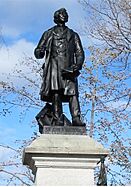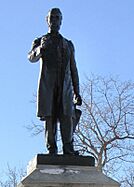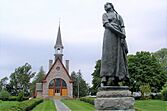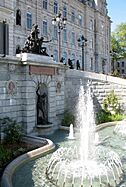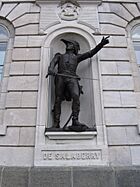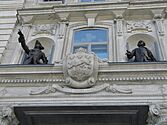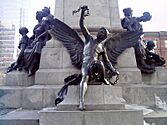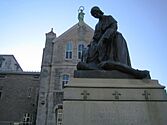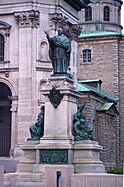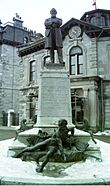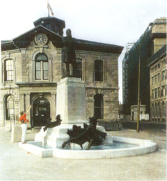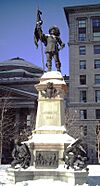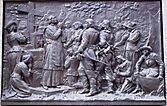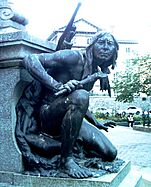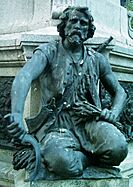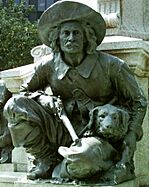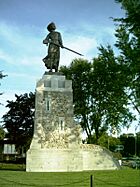Louis-Philippe Hébert facts for kids
Quick facts for kids
Louis-Philippe Hébert
|
|
|---|---|
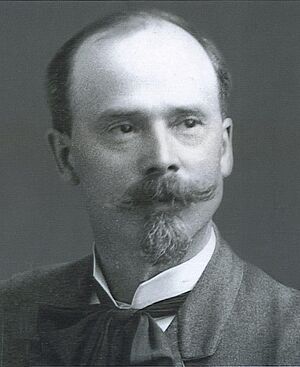
Louis-Philippe Hébert
|
|
| Born | 27 January 1850 Ste-Sophie de Mégantic, Canada East
|
| Died | 13 June 1917 |
| Education | Napoléon Bourassa |
| Known for | sculptor, educator |
Louis-Philippe Hébert (born January 27, 1850 – died June 13, 1917) was a famous Canadian sculptor. He is known as one of the best sculptors of his time. He created many important statues and monuments across Canada.
Contents
Becoming a Sculptor
Louis-Philippe Hébert grew up on a farm in Canada East. When he was 19, he traveled to Italy. This trip was a big eye-opener for him. He saw amazing art there, which really inspired him.
After returning to Canada in 1872, he started learning how to sculpt. He first learned to carve wood from Adolphe Rho. Then, Napoléon Bourassa taught him new ways to create sculptures. Hébert became very skilled. He made over forty monuments, busts, medals, and statues. He used materials like wood, bronze, and terra-cotta. He also taught art at a school in Montreal, Quebec.
Louis-Philippe Hébert married Maria Roy in 1879. They had eight children together. Two of their children also became artists. Henri Hébert became a sculptor, and Adrien Hébert became a painter.
Awards and Recognition
Hébert was a member of the Royal Canadian Academy of Arts. This is a group for important Canadian artists. In 1889, he won a bronze medal at a big art show in Paris, France. This was the first time a Canadian artist had won such an award.
He also received other special honors. He got the Medal of Confederation in 1894. In 1901, France gave him the Legion of Honour award. Great Britain also honored him in 1903. An art award called the Prix Philippe-Hébert is now named after him. It is given to talented artists in Québec. Louis-Philippe Hébert was buried in Montreal, Quebec.
Famous Works
Louis-Philippe Hébert created many well-known sculptures. You can see his art in many cities.
Parliament Hill, Ottawa
-
Statue of Sir George-Étienne Cartier (1880s) at Parliament Hill in Ottawa, Ontario.
-
Statue of Sir John A. Macdonald (1880s).
-
Statue of Queen Victoria (1900).
-
Statue of Alexander Mackenzie (1901).
Nova Scotia Monuments
-
The Evangeline statue (unveiled 1920) in Grand Pre, Nova Scotia.
-
Statue of Joseph Howe (1904) at Province House in Halifax, Nova Scotia.
-
The Libel trial of Joseph Howe sculpture at Province House (Nova Scotia).
Quebec Parliament Building
-
Statue of Charles-Michel de Salaberry.
-
Statue of James Bruce, 8th Earl of Elgin.
-
Statues of James Wolfe and Marquis de Montcalm.
Montreal, Quebec Sculptures
-
The Edward VII Monument (Montreal) (1914) in Phillips Square.
-
A detail from the Edward VII Monument (Montreal).
-
The Jeanne Mance Monument at l'hôtel-Dieu.
-
Another view of the Jeanne Mance Monument.
-
The Ignace Bourget Monument (1903) in front of Mary, Queen of the World Cathedral.
Maisonneuve Monument
-
The Maisonneuve Monument (1895) in Place d'Armes square. It honors Paul Chomedey de Maisonneuve.
-
A sculpture representing the Iroquois people.
-
A sculpture of Jeanne Mance.
Other Notable Works
-
Statue of Bishop Joseph Eugene Guiges outside Notre-Dame Cathedral Basilica, Ottawa.
-
The Boer War monument in Central Memorial Park, Calgary, Alberta.
- He sculpted a statue of Monseigneur Bourget in Montreal, Quebec.
- He created a statue of Monseigneur de Laval in Quebec, Quebec.
- He made thirty large wooden sculptures for the choir of the Notre-Dame Cathedral Basilica, Ottawa. These included the Holy Family, John the Baptist, and Patrick.
- He sculpted a monument at Parliament Hill (Quebec City) for soldiers Short and Wallick. They were heroes who saved people from a fire in Quebec in 1889.
- He also made a monument of Father André Garin in Lowell, Massachusetts.



